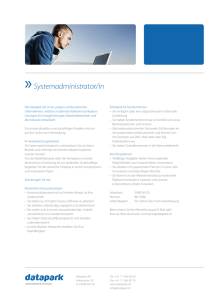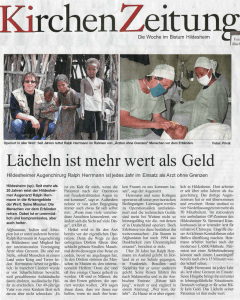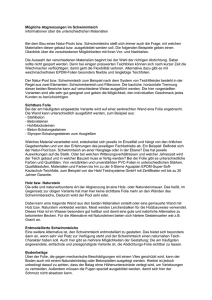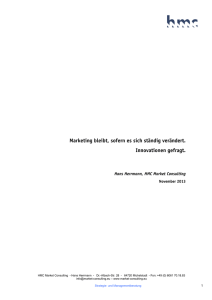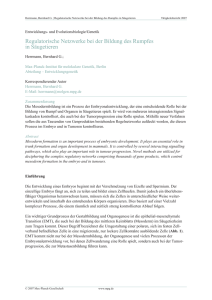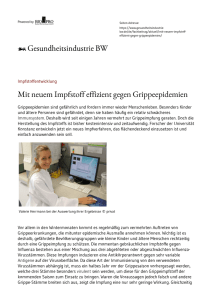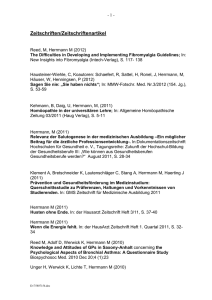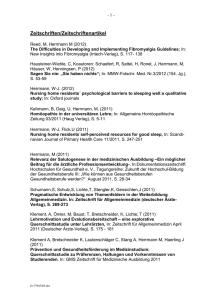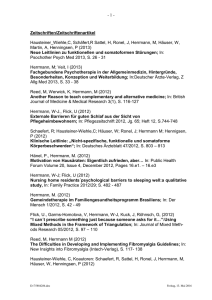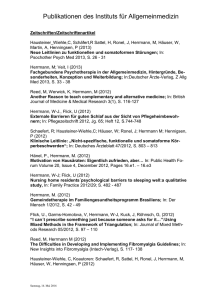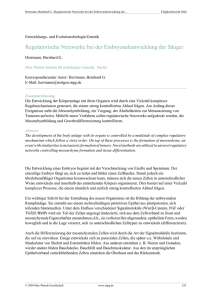Forschungsprofil Herrmann2 - Graduate School of the SFB 643
Werbung
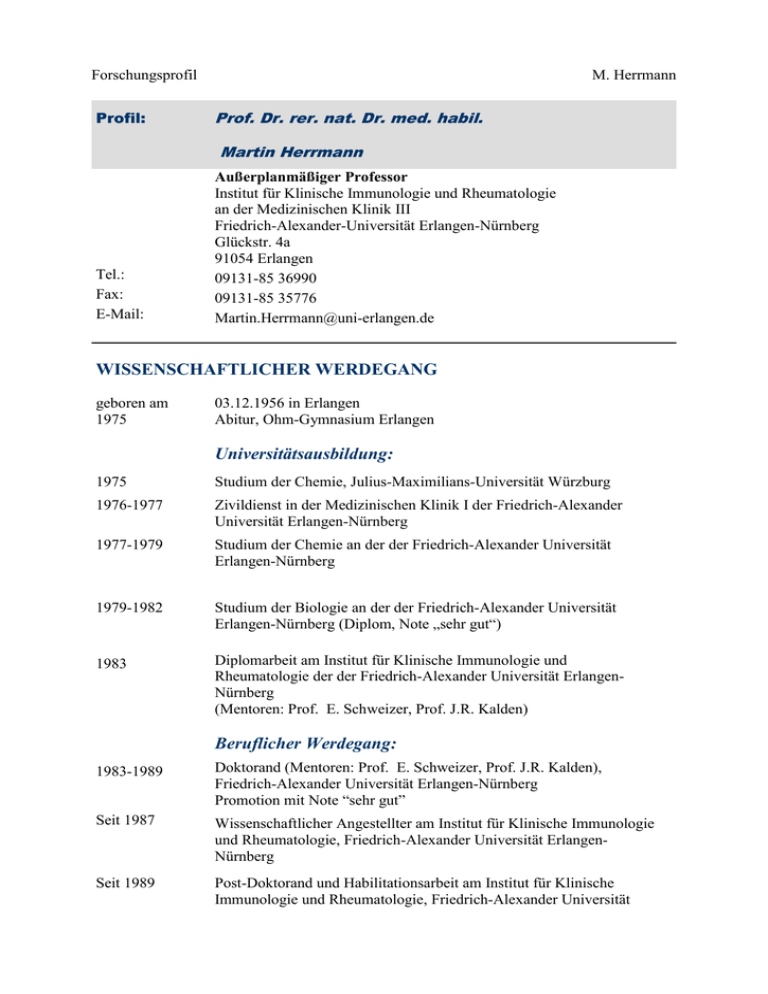
Forschungsprofil Profil: M. Herrmann Prof. Dr. rer. nat. Dr. med. habil. Martin Herrmann Tel.: Fax: E-Mail: Außerplanmäßiger Professor Institut für Klinische Immunologie und Rheumatologie an der Medizinischen Klinik III Friedrich-Alexander-Universität Erlangen-Nürnberg Glückstr. 4a 91054 Erlangen 09131-85 36990 09131-85 35776 [email protected] WISSENSCHAFTLICHER WERDEGANG geboren am 1975 03.12.1956 in Erlangen Abitur, Ohm-Gymnasium Erlangen Universitätsausbildung: 1975 Studium der Chemie, Julius-Maximilians-Universität Würzburg 1976-1977 Zivildienst in der Medizinischen Klinik I der Friedrich-Alexander Universität Erlangen-Nürnberg 1977-1979 Studium der Chemie an der der Friedrich-Alexander Universität Erlangen-Nürnberg 1979-1982 Studium der Biologie an der der Friedrich-Alexander Universität Erlangen-Nürnberg (Diplom, Note „sehr gut“) 1983 Diplomarbeit am Institut für Klinische Immunologie und Rheumatologie der der Friedrich-Alexander Universität ErlangenNürnberg (Mentoren: Prof. E. Schweizer, Prof. J.R. Kalden) Beruflicher Werdegang: 1983-1989 Doktorand (Mentoren: Prof. E. Schweizer, Prof. J.R. Kalden), Friedrich-Alexander Universität Erlangen-Nürnberg Promotion mit Note “sehr gut” Seit 1987 Wissenschaftlicher Angestellter am Institut für Klinische Immunologie und Rheumatologie, Friedrich-Alexander Universität ErlangenNürnberg Seit 1989 Post-Doktorand und Habilitationsarbeit am Institut für Klinische Immunologie und Rheumatologie, Friedrich-Alexander Universität Forschungsprofil M. Herrmann Erlangen-Nürnberg 1992 - 1993 Studienaufenthalt an der Universität von Alabama in Birmingham, Arbeitsgruppe Prof. S. Gay 1997 Habilitation Seit 1998 Privatdozent am Institut für Klinische Immunologie und Rheumatologie, Friedrich-Alexander Universität Erlangen-Nürnberg Seit 2004 Außerplanmäßiger Professor am Institut für Klinische Immunologie und Rheumatologie, Friedrich-Alexander Universität ErlangenNürnberg Mitgliedschaften: Kunkel Society Preise und Gutachterfunktionen: Seit 2000 Seit 2008 2009 Sprecher, DFG-integriertes Graduiertenkolleg des SFB 643 Member of the Bording and Scientific Commitee at the Winter Meeting of Proteins and Autoimmunity January 29th – 31st 2009 in Courmayeur, Italy Member of the International Advisory Board of our 9th Dresden Symposium on Autoantibodies "From Pathogenesis to Therapy of Autoimmune Diseases" from September 2 to September 5, 2009 in Dresden, Germany Senior editor of Autoimmunity 2009 Consultant Gerson Lehrman Group, New York 2009 2009 ab 1992 Gutachter für wissenschaftliche Journale: EMBO Journal European Journal of Immunology Immunobiology International Immunology Journal of Immunology Cancer Research Trends in Parasitology Autoimmunity Rheumatology International Rheumatology (Oxford) Arthritis and Rheumatology Seminar Arthritis and Rheumatology Nature Medicine Journal of Immunology Gutachter für Förderorganisationen: Israel Science Foundation (ISF) Forschungsprofil M. Herrmann FORSCHUNGSSCHWERPUNKTE Clearance von apoptopischen Zellen Autoimmunität Tumor Vaccination EXTERN BEGUTACHTETE FORSCHUNGSFÖRDERUNG (ab 2004) (* für das Kolleg relevante Projekte) Fördereinrichtung Titel/Antragsteller Laufzeit Beantragte Projekte: *DFG Analyse der mechanischen Eigenschaften von Zellen während der Apoptose Antragsteller: Claudia Mierke und Martin Herrmann 3 Jahre *Fonds für Forschung und Lehre des Klinikums der FriedrichAlexanderUniversität ErlangenNürnberg (ELAN) Analyse der an der Clearance apoptotischer Zellen beteiligten phagozytotischen Synapse Antragsteller: Martin Herrmann und Luis Munoz 1 Jahr *Wilhelm SanderStiftung Ein Doxycyclin-abhängiger T-Zell-Suizid zur Kontrolle der graft-versus-hostReaktion beim adoptiven Immuntransfer Antragsteller: Martin Herrmann und Wolfgang Hillen Ingesamt 4 Jahre (Fortsetzu ngsantrag) Grand Challenges Explorations Bill & Melinda Gates Foundation New adjuvant to break leishmania Trojan horse strategy, eliminating the reservoir of the parasite Antragsteller: Ger van Zandbergen und Martin Herrmann 5 Jahre Laufende Projekte: *Research Training Grant from the German Research Foundation The role of galectins in immunmodulation Antragsteller: Martin Herrmann 10/0609/09 Projekt Forschungsprofil M. Herrmann *Research Training Grant from the German Research Foundation Cellular Interactions of Dendritic Cellsurface-lectins Antragsteller: Martin Herrmann 10/0609/09 EURATOM Specific Program for Research and Training on Nuclear Energy and European Commission NOTE: Non targeted effects of ionising radiation Mitantragsteller: Martin Herrmann 09/0608/10 TPA4 FP6 *Interdisciplinary Centre of Clinical Research (IZKF): Disturbed clearance of apoptotic cells in germinal centres – reason fort eh antidsDNA autoantibodies in MFG-E8 knockout mice Antragsteller: Martin Herrmann Seit 10/2007 TPA25 *DFG SFB 643 (2.Förderperiode) Modulation of Phagocytosis and inflammation with the phosphatidylserineligand Annexin A5 Antragsteller: Martin Herrmann 08/0807/12 TPB5 *DFG Graduiertenkolleg des SFB 643 Modulation of Phagocytosis and inflammation with the phosphatidylserineligand Annexin A5 Antragsteller: Martin Herrmann 10/0809/09 TPGK Deutsches Institut für Luft- und Raumfahrt e.V. – Internationales Büro des BMBF Veränderungen in der Glykokalyx der Plasmamembranen von apoptotischen Zellen. Auswirkungen für Autoimmunität Antragsteller: Martin Herrmann 04/0909/10 UKR08/ 035 K. und R. Wucherpfennigstif tung Die Bedeutung von C reaktives Protein in der Transplantation Antragsteller: Martin Herrmann 01/0806/10 Abgeschlossene Projekte: *Institut für Klinische Immunologie und Rheumatologie der Universität ErlangenNürnberg (IZKF) Die Bedeutung spezifischer Phagozytenrezeptoren und des Komplementsystems bei der Phagozytose apoptotischer und nekrotischer Zellen Konsequenzen für die Pathogenese des systemischen Lupus erythematodes Projektleiter: Martin Herrmann 19992004 TPB28 Forschungsprofil M. Herrmann Doktor Robert Pfleger-Stiftung Hydrostatischer Hochdruck als Stimulus des Zelltodes von Säugerzellen – Analyse des Zelltodes hinsichtlich Apoptose, Nekrose und Mischformen. Immunogenität hochdruckbehandekter Zellen Projektleiter: Martin Herrmann 12/2004 *European Commissions (EU) (Antrag DG RTD) Clearance of apoptotic cells: discovery of autoantigens and therapy for autoimmune diseases, Antragsteller: Martin Herrmann 10/0209/05 *GRK 592 „Lymphozyten Differenzierung, Aktivierung und Deviation“ mit den Projekten: 1 ) Erkennung und Phagozytose apoptotischer und nekrotischer Lymphozyten“ und 2) „Induktion von Zelltod durch hydrostatischen Hochdruck – Immunogenität hochdruckbehandelter Zellen“. Projektleiter: Martin Herrmann 04/0303/06 *GRK 592 „Lymphozyten Differenzierung, Aktivierung und Deviation“ mit den Projekten: 1 ) Erkennung und Phagozytose apoptotischer und nekrotischer Lymphozyten“ und 2) „Induktion von Zelltod durch hydrostatischen Hochdruck – Immunogenität hochdruckbehandelter Zellen“. Projektleiter: Martin Herrmann 04/0603/09 SDME 9/26 2.Förderperiode *Institut für Klinische Immunologie und Rheumatologie der Universität ErlangenNürnberg (IZKF) Bedeutung der Oberflächenveränderungen und der Freisetzung intrazellulärer Gefahrensignale sterbender Zellen für die Entzündungsreaktion Projektleiter: Martin Herrmann 11/0410/07 Fonds für Forschung und Lehre des Klinikums der FriedrichAlexanderUniversität Erlangen- Immunmodulatorische Wirkung von UV-A Licht und 8-Methoxy-Psoralen – Wirkungsmechanismen der Photophorese Antragsteller: Udo Gaipl, Axel Hueber 03/0712/07 TPA4 Forschungsprofil M. Herrmann Nürnberg (ELAN) *DFG SFB 643 (1. Förderperiode) Modulation von Phagozytose und Entzündung durch den PhopshatidylserinLiganden Annexin A5 in vivo und in vitro Projektleiter: Martin Herrmann 08/0407/08 TPB5 PUBLIKATIONSVERZEICHNIS (*für das Kolleg relevante Publikationen) Begutachtete Originalpublikationen im Druck bzw. akzeptiert 1. * Urbonaviciute V, Fürnrohr BG, Meister S, Munoz L, Heyder P, Kalden JR, Manfredi AA, De Marchis F, Bianchi ME, Kirschning C, Schett G, Rovere-Querini P, Herrmann M, Voll RE (2009). Induction Of Inflammatory And Immune Responses By HMGB1-Nucleosome Complexes – Implications For The Immunopathogenesis Of SLE.. The Journal Of Experimental Medicine In Press 2. Luis E. Muñoz, Christina Janko, Connie Schulze, Christine Schorn, Kerstin Sarter, And Martin Herrmann (2009). Autoimmunity And Chronic Inflammation - Two ClearanceRelated Steps In The Etiopathogenesis Of SLE, Autoimmunity In Reviews, In Press 3. * Luis E. Munoz, MD, Christina Janko, Ricardo A. Chaurio, Udo S. Gaipl, And Martin Herrmann, Phd (2009). Igg OPSONIZED NUCLEAR REMNANTS FROM DEAD CELLS CAUSE SYSTEMIC INFLAMMATION IN SLE, Autoimmunity In Reviews, In Press 4. Christine Schorn, Moritz Strysio, Christina Janko, Luis E. Munoz, And Martin Herrmann (2009), The Uptake By Blood-Borne Phagocytes Of Monosodium Urate Is Dependent On Heat Labile Serum Factor(S) And Divalent Cations, Autoimmunity In Reviews, In Press 5. Martin Herrmann (2009), Constant Dripping Wears Away The Stone, Autoimmunity In Reviews, In Press 6. * Vilma Urbonaviciute, Silke Meister, Barbara G. Fürnrohr, Benjamin Frey, Eva Gückel, Georg Schett, Martin Herrmann, Reinhard E. Voll (2009), Oxidation Of The Alarmin Hmgb1 During Apo, Autoimmunity In Reviews, In Press 7. Christine Schorn, Christina Janko, Luis Munoz, Connie Schulze, Moritz Strysio, Georg Schett, And Martin Herrmann (2009), Sodium And Potassum Urate Crystals Differ In Their Inflammatory Potential, Autoimmunity In Reviews, In Press 8. Gaipl, U.S, Meister, S., Lödermann, B., Rödel, F., Fietkau, R., Herrmann, M., Kern, P.M., And Frey, B (2009). Activation-Induced Cell Death And Total Akt Content Of Granulocytes Show A Biphasic Course After Low Dose Radiation, Autoimmunity In Reviews, In Press 9. Franz Rödel, Ludwig Keilholz, Martin Herrmann, Christian Weiss, Benjamin Frey, Reinhard Voll, Udo Gaipl, Claus Rödel (2009), Activator Protein 1 (Ap-1) Shows A Biphasic Induction And Transcriptional Activity After Low Dose X-Irradiation In Ea.Hy.926 Endothelial Cells, Autoimmunity In Reviews, In Press 10. Frey, B. Gaipl, U.S. Sarter, K. Zaiss, M.M. Stillkrieg, W. Rödel, F, Schett, G. Herrmann, M. Fietkau R. And Keilholz, L (2009)., Whole Body Low Dose Irradiation Improves The Forschungsprofil M. Herrmann Course Of Beginning Polyarthritis In Htnf-Transgenic Mice, Autoimmunity In Reviews, In Press 11. * Munoz Luis, Janko Christina, Grossmayer Gerhard, Frey Benjamin, Voll Reinhard, Kern Peter, Kalden Joachim, Schett Georg, Fietkau Rainer, Herrmann Martin, Gaipl Udo (2009), Remnants Of Secondarily Necrotic Cells Fuel Inflammation In Systemic Lupus Erythematosus (SLE), Arthritis And Rheumatism, In Press Begutachtete Originalpublikationen – Veröffentlicht (ab 2003) 1. * Sarter, K., S. Andre, H. Kaltner, M. Lensch, C. Schulze, V. Urbonaviciute, G. Schett, M. Herrmann, and H. J. Gabius. (2009). Detection and chromatographic removal of lipopolysaccharide in preparations of multifunctional galectins. Biochem Biophys Res Commun 379:155-159. 2. Raaz, D., M. Herrmann, A. B. Ekici, L. Klinghammer, B. Lausen, R. E. Voll, J. H. Leusen, J. G. van de Winkel, W. G. Daniel, A. Reis, and C. D. Garlichs. (2009). FcgammaRIIa genotype is associated with acute coronary syndromes as first manifestation of coronary artery disease. Atherosclerosis. 3. Maler, J. M., P. Spitzer, H. W. Klafki, H. Esselmann, P. Lewczuk, J. Kornhuber, M. Herrmann, and J. Wiltfang. (2009). Distinct fractional Abeta release patterns in human mononuclear phagocytes. J Neuroimmunol 206:1-4. 4. * Urbonaviciute, V., B. G. Furnrohr, S. Meister, L. Munoz, P. Heyder, F. De Marchis, M. E. Bianchi, C. Kirschning, H. Wagner, A. A. Manfredi, J. R. Kalden, G. Schett, P. RovereQuerini, M. Herrmann, and R. E. Voll. (2008). Induction of inflammatory and immune responses by HMGB1-nucleosome complexes: implications for the pathogenesis of SLE. J Exp Med 205:3007-3018. 5. Maseda, D., S. Meister, K. Neubert, M. Herrmann, and R. E. Voll. (2008). Proteasome inhibition drastically but reversibly impairs murine lymphocyte development. Cell Death Differ 15:600-612. 6. Maler, J. M., P. Spitzer, H. W. Klafki, H. Esselmann, M. Bibl, P. Lewczuk, J. Kornhuber, M. Herrmann, and J. Wiltfang. (2008). Adherence-dependent shifts in the patterns of betaamyloid peptides secreted by human mononuclear phagocytes. Brain Behav Immun 22:1044-1048. 7. * Grossmayer, G. E., L. E. Munoz, C. K. Weber, S. Franz, R. E. Voll, P. M. Kern, J. R. Kalden, G. Schett, M. Herrmann, and U. S. Gaipl. (2008). IgG autoantibodies bound to surfaces of necrotic cells and complement C4 comprise the phagocytosis promoting activity for necrotic cells of systemic lupus erythaematosus sera. Ann Rheum Dis 67:1626-1632. 8. * Frey, B., L. E. Munoz, F. Pausch, R. Sieber, S. Franz, B. Brachvogel, E. Poschl, H. Schneider, F. Rodel, R. Sauer, R. Fietkau, M. Herrmann, and U. S. Gaipl. (2008). The immune reaction against allogeneic necrotic cells is reduced in AnnexinA5 knock out mice whose macrophages display an anti-inflammatory phenotype. J Cell Mol Med. 9. Beer, A., S. Andre, H. Kaltner, M. Lensch, S. Franz, K. Sarter, C. Schulze, U. S. Gaipl, P. Kern, M. Herrmann, and H. J. Gabius. (2008). Human galectins as sensors for apoptosis/necrosis-associated surface changes of granulocytes and lymphocytes. Cytometry A 73:139-147. 10. Axmann, R., S. Herman, M. Zaiss, S. Franz, K. Polzer, J. Zwerina, M. Herrmann, J. Smolen, and G. Schett. (2008). CTLA-4 directly inhibits osteoclast formation. Ann Rheum Dis 67:1603-1609. Forschungsprofil M. Herrmann 11. * Urbonaviciute, V., B. G. Furnrohr, C. Weber, M. Haslbeck, S. Wilhelm, M. Herrmann, and R. E. Voll. (2007). Factors masking HMGB1 in human serum and plasma. J Leukoc Biol 81:67-74. 12. Rodel, F., L. Keilholz, M. Herrmann, R. Sauer, and G. Hildebrandt. (2007). Radiobiological mechanisms in inflammatory diseases of low-dose radiation therapy. Int J Radiat Biol 83:357-366. 13. Munoz, L. E., S. Franz, F. Pausch, B. Furnrohr, A. Sheriff, B. Vogt, P. M. Kern, W. Baum, C. Stach, D. von Laer, B. Brachvogel, E. Poschl, M. Herrmann, and U. S. Gaipl. (2007). The influence on the immunomodulatory effects of dying and dead cells of Annexin V. J Leukoc Biol 81:6-14. 14. Meister, S., U. Schubert, K. Neubert, K. Herrmann, R. Burger, M. Gramatzki, S. Hahn, S. Schreiber, S. Wilhelm, M. Herrmann, H. M. Jack, and R. E. Voll. (2007). Extensive immunoglobulin production sensitizes myeloma cells for proteasome inhibition. Cancer Res 67:1783-1792. 15. Marlies, A., G. Udo, B. Juergen, S. Bernd, M. Herrmann, and J. P. Haas. (2007). The expanded double negative T cell populations of a patient with ALPS are not clonally related to CD4+ or to CD8+ T cells. Autoimmunity 40:299-301. 16. Horner, H., C. Frank, C. Dechant, R. Repp, M. Glennie, M. Herrmann, and B. Stockmeyer. (2007). Intimate cell conjugate formation and exchange of membrane lipids precede apoptosis induction in target cells during antibody-dependent, granulocyte-mediated cytotoxicity. J Immunol 179:337-345. 17. * Gaipl, U. S., L. E. Munoz, G. Grossmayer, K. Lauber, S. Franz, K. Sarter, R. E. Voll, T. Winkler, A. Kuhn, J. Kalden, P. Kern, and M. Herrmann. (2007). Clearance deficiency and systemic lupus erythematosus (SLE). J Autoimmun 28:114-121. 18. Furnrohr, B. G., G. J. Groer, B. Sehnert, M. Herrmann, and R. E. Voll. (2007). Interaction of histones with phospholipids--implications for the exposure of histones on apoptotic cells. Autoimmunity 40:322-326. 19. * Franz, S., K. Herrmann, B. G. Furnrohr, A. Sheriff, B. Frey, U. S. Gaipl, R. E. Voll, J. R. Kalden, H. M. Jack, and M. Herrmann. (2007). After shrinkage apoptotic cells expose internal membrane-derived epitopes on their plasma membranes. Cell Death Differ 14:733742. 20. Frey, B., M. Hartmann, M. Herrmann, R. Meyer-Pittroff, K. Sommer, and G. Bluemelhuber. (2006). Microscopy under pressure--an optical chamber system for fluorescence microscopic analysis of living cells under high hydrostatic pressure. Microsc Res Tech 69:65-72. 21. * Franz, S., B. Frey, A. Sheriff, U. S. Gaipl, A. Beer, R. E. Voll, J. R. Kalden, and M. Herrmann. (2006). Lectins detect changes of the glycosylation status of plasma membrane constituents during late apoptosis. Cytometry A 69:230-239. 22. * Bottcher, A., U. S. Gaipl, B. G. Furnrohr, M. Herrmann, I. Girkontaite, J. R. Kalden, and R. E. Voll. (2006). Involvement of phosphatidylserine, alphavbeta3, CD14, CD36, and complement C1q in the phagocytosis of primary necrotic lymphocytes by macrophages. Arthritis Rheum 54:927-938. 23. * Wellmann, U., M. Letz, M. Herrmann, S. Angermuller, J. R. Kalden, and T. H. Winkler. (2005). The evolution of human anti-double-stranded DNA autoantibodies. Proc Natl Acad Sci U S A 102:9258-9263. 24. Schlenk, J., H. M. Lorenz, J. P. Haas, M. Herrmann, G. Hohenberger, J. R. Kalden, M. Rollinghoff, and H. U. Beuscher. (2005). Extravasation into synovial tissue induces CCL20 Forschungsprofil M. Herrmann mRNA expression in polymorphonuclear neutrophils of patients with rheumatoid arthritis. J Rheumatol 32:2291-2298. 25. Rodel, F., J. Hoffmann, L. Distel, M. Herrmann, T. Noisternig, T. Papadopoulos, R. Sauer, and C. Rodel. (2005). Survivin as a radioresistance factor, and prognostic and therapeutic target for radiotherapy in rectal cancer. Cancer Res 65:4881-4887. 26. Rodel, F., S. Franz, A. Sheriff, U. Gaipl, P. Heyder, G. Hildebrandt, S. Schultze-Mosgau, R. E. Voll, and M. Herrmann. (2005). The CFSE distribution assay is a powerful technique for the analysis of radiation-induced cell death and survival on a single-cell level. Strahlenther Onkol 181:456-462. 27. Kolowos, W., U. S. Gaipl, A. Sheriff, R. E. Voll, P. Heyder, P. Kern, J. R. Kalden, and M. Herrmann. (2005). Microparticles shed from different antigen-presenting cells display an individual pattern of surface molecules and a distinct potential of allogeneic T-cell activation. Scand J Immunol 61:226-233. 28. Knott, A., L. Drueppel, T. Beyer, K. Garke, C. Berens, M. Herrmann, and W. Hillen. (2005). An optimized conditional suicide switch using doxycycline-dependent expression of human tBid. Cancer Biol Ther 4:532-536. 29. Brinkman, M., J. Walter, S. Grein, M. J. Thies, T. W. Schulz, M. Herrmann, C. O. Reiser, and J. Hess. (2005). Beneficial therapeutic effects with different particulate structures of murine polyomavirus VP1-coat protein carrying self or non-self CD8 T cell epitopes against murine melanoma. Cancer Immunol Immunother 54:611-622. 30. * Sheriff, A., U. S. Gaipl, S. Franz, P. Heyder, R. E. Voll, J. R. Kalden, and M. Herrmann. (2004). Loss of GM1 surface expression precedes annexin V-phycoerythrin binding of neutrophils undergoing spontaneous apoptosis during in vitro aging. Cytometry A 62:75-80. 31. Rodel, F., U. Schaller, S. Schultze-Mosgau, H. U. Beuscher, L. Keilholz, M. Herrmann, R. Voll, R. Sauer, and G. Hildebrandt. (2004). The induction of TGF-beta(1) and NF-kappaB parallels a biphasic time course of leukocyte/endothelial cell adhesion following low-dose X-irradiation. Strahlenther Onkol 180:194-200. 32. Rodel, F., M. Hantschel, G. Hildebrandt, S. Schultze-Mosgau, C. Rodel, M. Herrmann, R. Sauer, and R. E. Voll. (2004). Dose-dependent biphasic induction and transcriptional activity of nuclear factor kappa B (NF-kappaB) in EA.hy.926 endothelial cells after lowdose X-irradiation. Int J Radiat Biol 80:115-123. 33. Korn, A., B. Frey, A. Sheriff, U. S. Gaipl, S. Franz, R. Meyer-Pittroff, G. Bluemelhuberh, and M. Herrmann. (2004). High hydrostatic pressure inactivated human tumour cells preserve their immunogenicity. Cell Mol Biol (Noisy-le-grand) 50:469-477. 34. * Gaipl, U. S., T. D. Beyer, P. Heyder, S. Kuenkele, A. Bottcher, R. E. Voll, J. R. Kalden, and M. Herrmann. (2004). Cooperation between C1q and DNase I in the clearance of necrotic cell-derived chromatin. Arthritis Rheum 50:640-649. 35. Dumitriu, I. E., R. E. Voll, W. Kolowos, U. S. Gaipl, P. Heyder, J. R. Kalden, and M. Herrmann. (2004). UV irradiation inhibits ABC transporters via generation of ADP-ribose by concerted action of poly(ADP-ribose) polymerase-1 and glycohydrolase. Cell Death Differ 11:314-320. 36. Stockmeyer, B., T. Beyer, W. Neuhuber, R. Repp, J. R. Kalden, T. Valerius, and M. Herrmann. (2003). Polymorphonuclear granulocytes induce antibody-dependent apoptosis in human breast cancer cells. J Immunol 171:5124-5129. 37. Heyder, P., U. S. Gaipl, T. D. Beyer, R. E. Voll, P. M. Kern, C. Stach, J. R. Kalden, and M. Herrmann. (2003). Early detection of apoptosis by staining of acid-treated apoptotic cells with FITC-labeled lectin from Narcissus pseudonarcissus. Cytometry A 55:86-93. Forschungsprofil M. Herrmann 38. Dumitriu, I. E., F. Roedel, T. D. Beyer, U. S. Gaipl, J. R. Kalden, and M. Herrmann. (2003). UV or X-irradiation increases the cytoplasmic accumulation of rhodamine 123 in various cancer cell lines. Strahlenther Onkol 179:564-570. Begutachtete Übersichtsartikel 1. * Voll, R. E., V. Urbonaviciute, M. Herrmann, and J. R. Kalden. (2008). High mobility group box 1 in the pathogenesis of inflammatory and autoimmune diseases. Isr Med Assoc J 10:26-28. 2. * Voll, R. E., V. Urbonaviciute, B. Furnrohr, M. Herrmann, and J. R. Kalden. (2008). The role of high-mobility group box 1 protein in the pathogenesis of autoimmune diseases. Curr Rheumatol Rep 10:341-342. 3. * Schulze, C., L. E. Munoz, S. Franz, K. Sarter, R. A. Chaurio, U. S. Gaipl, and M. Herrmann. (2008). Clearance deficiency--a potential link between infections and autoimmunity. Autoimmun Rev 8:5-8. 4. * Munoz, L. E., C. van Bavel, S. Franz, J. Berden, M. Herrmann, and J. van der Vlag. (2008). Apoptosis in the pathogenesis of systemic lupus erythematosus. Lupus 17:371-375. 5. * Munoz, L. E., U. S. Gaipl, and M. Herrmann. (2008). Predictive value of anti-dsDNA autoantibodies: importance of the assay. Autoimmun Rev 7:594-597. 6. * Janko, C., C. Schorn, G. E. Grossmayer, B. Frey, M. Herrmann, U. S. Gaipl, and L. E. Munoz. (2008). Inflammatory clearance of apoptotic remnants in systemic lupus erythematosus (SLE). Autoimmun Rev 8:9-12. 7. Frey, B., C. Janko, N. Ebel, S. Meister, E. Schlucker, R. Meyer-Pittroff, R. Fietkau, M. Herrmann, and U. S. Gaipl. (2008). Cells under pressure - treatment of eukaryotic cells with high hydrostatic pressure, from physiologic aspects to pressure induced cell death. Curr Med Chem 15:2329-2336. 8. Munoz, L. E., B. Frey, F. Pausch, W. Baum, R. B. Mueller, B. Brachvogel, E. Poschl, F. Rodel, K. von der Mark, M. Herrmann, and U. S. Gaipl. (2007). The role of annexin A5 in the modulation of the immune response against dying and dead cells. Curr Med Chem 14:271-277. 9. Maler, J. M., P. Spitzer, P. Lewczuk, J. Kornhuber, M. Herrmann, and J. Wiltfang. (2006). Decreased circulating CD34+ stem cells in early Alzheimer's disease: Evidence for a deficient hematopoietic brain support? Mol Psychiatry 11:1113-1115. 10. * Gaipl, U. S., A. Sheriff, S. Franz, L. E. Munoz, R. E. Voll, J. R. Kalden, and M. Herrmann. (2006). Inefficient clearance of dying cells and autoreactivity. Curr Top Microbiol Immunol 305:161-176. 11. * Gaipl, U. S., A. Kuhn, A. Sheriff, L. E. Munoz, S. Franz, R. E. Voll, J. R. Kalden, and M. Herrmann. (2006). Clearance of apoptotic cells in human SLE. Curr Dir Autoimmun 9:173187. 12. * Franz, S., U. S. Gaipl, L. E. Munoz, A. Sheriff, A. Beer, J. R. Kalden, and M. Herrmann. (2006). Apoptosis and autoimmunity: when apoptotic cells break their silence. Curr Rheumatol Rep 8:245-247. 13. * Munoz, L. E., M. Herrmann, and U. S. Gaipl. (2005). [An impaired detection and clearance of dying cells can lead to the development of chronic autoimmunity]. Z Rheumatol 64:370-376. Forschungsprofil M. Herrmann 14. * Munoz, L. E., U. S. Gaipl, S. Franz, A. Sheriff, R. E. Voll, J. R. Kalden, and M. Herrmann. (2005). SLE--a disease of clearance deficiency? Rheumatology (Oxford) 44:1101-1107. 15. * Grossmayer, G. E., L. E. Munoz, U. S. Gaipl, S. Franz, A. Sheriff, R. E. Voll, J. R. Kalden, and M. Herrmann. (2005). Removal of dying cells and systemic lupus erythematosus. Mod Rheumatol 15:383-390. 16. * Gaipl, U. S., R. E. Voll, A. Sheriff, S. Franz, J. R. Kalden, and M. Herrmann. (2005). Impaired clearance of dying cells in systemic lupus erythematosus. Autoimmun Rev 4:189194. 17. Brunner, J., P. M. Kern, U. S. Gaipl, L. E. Munoz, R. E. Voll, J. R. Kalden, C. W. Wiesenhutter, and M. Herrmann. (2005). The low-throughput protein A adsorber: an immune modulatory device. Hypothesis for the mechanism of action in the treatment of rheumatoid arthritis. Mod Rheumatol 15:9-18. 18. * Sheriff, A., U. S. Gaipl, R. E. Voll, J. R. Kalden, and M. Herrmann. (2004). Apoptosis and systemic lupus erythematosus. Rheum Dis Clin North Am 30:505-527, viii-ix. 19. * Gaipl, U. S., S. Franz, R. E. Voll, A. Sheriff, J. R. Kalden, and M. Herrmann. (2004). Defects in the disposal of dying cells lead to autoimmunity. Curr Rheumatol Rep 6:401-407. 20. Kuenkele, S., T. D. Beyer, R. E. Voll, J. R. Kalden, and M. Herrmann. (2003). Impaired * clearance of apoptotic cells in systemic lupus erythematosus: challenge of T and B cell tolerance. Curr Rheumatol Rep 5:175-177. 21. * Gaipl, U. S., T. D. Beyer, I. Baumann, R. E. Voll, C. M. Stach, P. Heyder, J. R. Kalden, A. Manfredi, and M. Herrmann. (2003). Exposure of anionic phospholipids serves as antiinflammatory and immunosuppressive signal--implications for antiphospholipid syndrome and systemic lupus erythematosus. Immunobiology 207:73-81. Zur Begutachtung eingereichte Publikationen (mit Datum) 1. Christine Schorn, Benjamin Frey, Moritz Strysio, Christina Janko, Reinhard E. Voll, Eva Springer, Georg Schett, Martin Herrmann,, Sodium overload and water influx activate the NALP3 inflammasome, eingereicht bei Nature Medicine am 30.04.2009 BETREUUNG DES WISSENSCHAFTLICHEN NACHWUCHSES Laufende Promotionsarbeiten Name Thema Beginn Manuskripte Munoz Luis Fate of Circulating Secondarily NEcrotic Cell-derived material (SNEC) in patients with SLE 10/04 14 Sarter Kerstin Galectins as immunmodulatory agents 09/06 9 Forschungsprofil M. Herrmann Schulze Connie Cellular Interactions of DCsurface-lectins with Glycoligands of Dying Cells 09/06 7 Kruse Kristin Reduzierte Phagozytose apoptotischer Zellen – Folge von anti-dsDNA Antikörpern im Systemischen Lupus Erythematodes CRP in the opsonisation of dying cells 10/07 - 11/07 5 The role of uric acid and its crystals for inflammation and immunogenicity of late apoptotic cells Gewinnung von CD 34 positiven Zellen zur Erstellung eines humanisierten Mausmodells Die Rolle von Annexin für die Information und Immunogenität 05/08 4 Janko Christina Schorn Christine Finzel Stephanie Zirngibl Matthias 10/05 10/08 Abgeschlossene Promotionsarbeiten (seit 2004) Name Franz Sandra Frey Benjamin Thema Fingerprinting Apoptotic Cell Surfaces: Alterations of Glycocalyx and Membrane Composition Hochdruckbehandlung humaner Zellen als Grundlage für die Entwicklung einer Tumorvakzine Dauer 1 Manuskripte 4J 22 Postdoktorand Prof. Ian Dransfield Univ.of Edingburgh Medical School 3,5J 9 Postdoktorand PD Udo Gaipl Universitätsklinikum Erlangen Position Munoz Luis The influence on the immunomodulatory effects of dying and dead cells of Annexin V 2J 11 Postdoktorand/Nat. Wiss. Doktorand Prof. M. Herrmann Universitätsklinikum Erlangen Korn Andreas Inactivation of human tumour cells by hydrostatic pressure 1J 2 Ärztliche Tätigkeit Beer Alexandra Oberflächenveränderungen apoptotischer und nekrotischer Zellen und ihre Detektierbarkeit mit Hilfe von Galektinen 1J 3 Ärztliche Tätigkeit Grossmeyer Gerhard IgG autoantibodies bound to surfaces of necrotic cells and complement C4 comprise the phagocytosis promoting activity for necrotic cells of SLE sera 1J 4 Ärztliche Tätigkeit Forschungsprofil M. Herrmann
